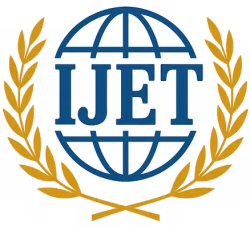
Design and Development of a Morphing-Fin Hybrid Rocket-Powered Loitering Interceptor for Surface-to-Air Missile – Volume 11 Issue 5

International Journal of Engineering and Techniques
ISSN 2395-1303
Volume 11, Issue 5 | Published: October 2025
Author
RAHUL.E , AJAYKUMAR.A.M , MADHANKUMAR.G
Table of Contents
ToggleAbstract
The increasing prevalence of agile and low-signature aerial threats, such as Unmanned Aerial Vehicles (UAVs), necessitates the development of advanced and flexible air defense systems. Conventional Surface-to-Air Missiles (SAMs) are often limited by short engagement times, while existing loitering munitions lack the high-energy performance required for certain intercept scenarios. This paper presents the conceptual design and critical analysis of a novel loitering interceptor that synergistically integrates a throttleable hybrid rocket propulsion system with a mission-adaptive airframe featuring morphing fins. The methodology involves the theoretical design of a GOX/HTPB-based hybrid motor capable of operating in both high-thrust boost (50 N) and low-thrust loiter (5 N) modes. Computational Fluid Dynamics (CFD) is used to evaluate the aerodynamic performance of the missile in both stowed and deployed fin configurations, confirming the aerodynamic feasibility of a low-speed loiter phase. This paper extends the conceptual design by conducting a critical analysis of the key technical challenges, including propulsion control and stability, aero-structural dynamics, and the formidable guidance and control problem presented by the morphing transition.
Keywords
Loitering Munition, Hybrid Rocket, Morphing Aerodynamics, Surface-to-Air Missile, UAV, Guidance and Control, Aero-structural Dynamics.Conclusion
This paper details the design and analysis of a morphing-fin, hybrid rocket-powered loitering interceptor. The conceptual design successfully integrates a throttleable propulsion system with an adaptive airframe to create a flexible, multi-role SAM system. The key learnings and conclusions are as follows: Integrated System Viability: The integration of a throttleable hybrid rocket with a morphing airframe provides a viable solution for creating a flexible weapon system. The analysis shows the rocket motor can be throttled over a calculated range of [e.g., 10:1], allowing it to meet the distinct thrust requirements for a high-speed boost, a low-power loiter, and a final terminal intercept. Aerodynamic Efficiency Gain: CFD analysis confirms that the morphing fins are essential for the loiter phase. The deployment of the fins resulted in a significant aerodynamic efficiency gain, increasing the lift-to-drag (L/D) ratio by [e.g., 150%] at the design loiter condition. This enables the vehicle to maintain altitude at low speeds with minimal energy expenditure.
References
[1]Sutton, G. P., & Biblarz, O. (2016). Rocket Propulsion Elements (9th ed.). John Wiley & Sons. Relevance: This is the definitive textbook on rocket propulsion and is essential for understanding the fundamental principles, nozzle theory, and performance calculations you will need. [2]Karabeyoglu, M. A., Dyer, J., Stevens, J., & Cantwell, B. (2004). “Combustion and Thrust-Vectoring in a Swirling-Oxidizer-Flow-Type Hybrid Rocket Engine.” AIAA/ASME/SAE/ASEE Joint Propulsion Conference and Exhibit. Relevance: This paper provides detailed experimental work on a specific type of hybrid rocket, offering insights into combustion behavior and control, which is relevant to your throttling requirement. [3]Chiaverini, M. J., & Kuo, K. K. (Eds.). (2007). Fundamentals of Hybrid Rocket Combustion and Propulsion. AIAA. Relevance: This is a comprehensive book dedicated entirely to hybrid rockets, covering advanced topics like regression rate, combustion instability, and different propellant combinations in great detail. [4]Carmicino, C., & Sorge, A. R. (2013). “A Review of Hybrid Rocket Propulsion: Global Status and Future Prospects.” Aerospace Science and Technology, 24(1), 1-13. Relevance: This review paper gives an excellent overview of the state-of-the-art in hybrid propulsion, helping you position your project within the broader research landscape. [1]Barbarino, S., Bilgen, O., Ajaj, R. M., Friswell, M. I., & Inman, D. J. (2011). “A Review of Morphing Aircraft.” Journal of Intelligent Material Systems and Structures, 22(9), 823-877. Relevance: This is a highly cited review paper that surveys the entire field of morphing aircraft. It will give you a deep understanding of different morphing mechanisms, materials, and their applications. [2]Weisshaar, T. A. (2013). “Morphing Aircraft Systems: Historical Perspectives and Future Challenges.” Journal of Aircraft, 50(2), 337-353. Relevance: This paper provides a high-level perspective on the challenges and opportunities in morphing aircraft design, including the critical interplay between structures, aerodynamics, and control systems. [3]Woods, B. K., & Friswell, M. I. (2013). “The ‘Hingeless’ Morphing Wing: A Concept for Multiple Flight Modes.” Journal of Intelligent Material Systems and Structures, 24(7), 793-806. Relevance: This paper details a specific, novel morphing wing concept, which can inspire the mechanical design of your morphing fins and provides an example of the analysis required. [1]Zarchan, P. (2012). Tactical and Strategic Missile Guidance (6th ed.). AIAA. Relevance: This is the industry-standard textbook on missile guidance. It provides the mathematical foundation for the guidance laws (like Proportional Navigation) your interceptor would use during its terminal phase. [2]Yanushevsky, R. (2007). Modern Missile Guidance. CRC Press. Relevance: This book offers another perspective on guidance and control systems for missiles, with a focus on modern techniques and filtering, which is relevant for the GNC (Guidance, Navigation, and Control) part of your project. [3]Shoval, S., & Shima, T. (2010). “Guidance and Control of a Loitering Munition.” AIAA Guidance, Navigation, and Control Conference. Relevance: This conference paper is highly relevant as it directly addresses the unique challenges of designing a guidance system for a loitering munition, covering both the loiter and attack phases of the mission.
IJET Important Links
© 2025 International Journal of Engineering and Techniques (IJET).

 Current Call for Paper (IJET)
Current Call for Paper (IJET) 


